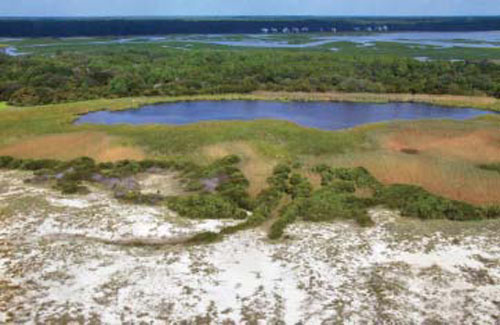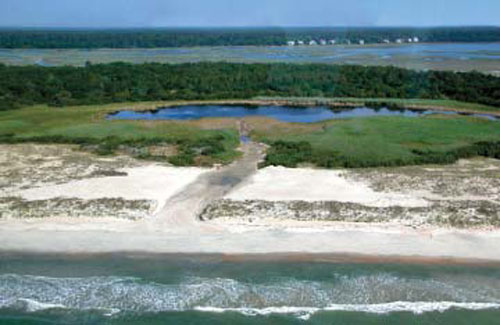Conserving America’s Wetlands 2008:
Four Years of Partnering Resulted in
Accomplishing the President's Goal
Appendix D.
Department of Commerce
National Oceanic & Atmospheric Administration (NOAA)
Table D-1. NOAA Programs Supporting the President's Wetlands Goal in FY 2009. Funding (millions of dollars)
| Agency |
Program | Restore or Create | Improve | Protect | Total Wetlands Funding for Goal FY 2009 | Difference from FY 2008 |
| NOAA |
Fisheries Habitat Restoration | 0.842 | 14.578 | 0.000 | 15.420 | -0.655 |
Table D-2. NOAA Programs Supporting the President's Wetlands Goal in FY 2009. Planned Accomplishments (in acres)
| Agency |
Program | Restore or Create | Improve | Protect | Total Wetlands FY 2009 | Difference from FY 2008 |
| NOAA |
Fisheries Habitat Restoration | 7,000 | 2,000 | 0 | 9.000 | 1000 |
NOAA Programs Supporting the President's Wetlands Goal
Community-based Restoration Program (CRP):
Under Fisheries and Habitat Restoration, the CRP applies a grassroots approach to restoration by actively engaging community members in on-the-ground restoration of coastal fishery habitats around the nation. The CRP embraces cooperative conservation, providing funding and technical expertise and
establishing partnerships that collaboratively restore NOAA trust resources to improve environmental quality and strengthen stewardship within local communities. FY 2009 funding request is $13.1 million.
http://www.nmfs.noaa.gov/habitat/restoration/projects_ programs/crp/
Great Lakes Habitat Restoration Program:
In FY 2009, NOAA will establish a cross-NOAA program to coordinate habitat restoration and protection efforts. Taking into account the priority needs identified by the Great Lakes Interagency Task Force, NOAA will focus its restoration and protection support on ongoing efforts at watersheds within Great Lakes Areas of Concern. FY 2009 funding request is $1.5 million.
http://www.corporateservices.noaa.gov/~nbo/08bluebook_highlights.html
NOAA Programs that Maintain the Wetlands Base
National Estuarine Research Reserve System:
This network of protected areas was established for long-term research, education, and stewardship. The partnership program between NOAA and the coastal states
protects more than one million acres of estuarine land and water, which provides essential habitat for wildlife; offers educational opportunities for students,
teachers, and the public; and serves as living laboratories for scientists. FY 2009 funding request for operations and program support is $17.1 million. Additionally, $6.89 million is requested for land acquisition and construction activities (lands acquired with these funds will be incorporated into reserve boundaries), and $5.2 million is requested for a competitive research program that will be administered by the NERRS program.
http://nerrs.noaa.gov
Coastal Zone Management Program (CZM):
The Coastal Zone Management (CZM) program is a voluntary federal–state partnership dedicated to comprehensive management of the nation’s coastal resources. State CZM programs contain provisions for the protection of estuaries, coastal wetlands, and other natural resources. Funding supports implementation of
state CZM programs, which include numerous state and local coastal habitat protection and restoration projects. FY 2009 funding request is $66.1 million.
http://coastalmanagement.noaa.gov/
Coastal and Estuarine Land Conservation Program (CELCP):
The CELCP was established to protect coastal and estuarine lands considered important for their ecological, conservation, recreational, historical, or aesthetic values, giving priority to lands with significant ecological values that can be effectively managed and protected. The program provides
funding to state and local governments to acquire such lands to ensure they are permanently conserved for the benefit of future generations. FY 2009 funding request is $15 million.
http://coastalmanagement.noaa.gov/land
Pacific Coastal Salmon Recovery Fund (PCSRF):
Congress established the PCSRF to contribute to the restoration and conservation of Pacific salmon and steelhead populations and their habitats. The states of Washington, Oregon, California, Idaho, and Alaska, and the Pacific Coastal and Columbia River tribes receive Congressional PCSRF appropriations from NOAA’s National Marine Fisheries Service each year. The fund supplements existing state, tribal, and local programs to foster development of federal-state-tribal-local partnerships in salmon and steelhead recovery and conservation. The President’s FY 2009 request for the fund is $35 million.
http://nwr.nmfs.noaa.gov/salmon-recovery-planning/pcsrf/
National Estuaries Restoration Inventory:
This program was created to track estuary habitat restoration projects across the nation. The purpose of the inventory is to provide information on restoration
projects in order to improve restoration methods, as well as to track acreage restored toward the millionacre goal of the Estuary Restoration Act.
http://neri.noaa.gov
Damage Assessment, Remediation, and Restoration Program (DARRP):
As a natural resource trustee, NOAA acts on behalf of the public to restore resources injured by oil spills, releases of other hazardous substances, and vessel
groundings. DARRP collaborates with other federal, state, and tribal natural resource trustees in assessing and quantifying injuries to natural resources, seeking damages for those injuries, implementing restoration actions, and monitoring progress to ensure restoration goals are met. FY 2009 funding request is $11.3 million.
http://response.restoration.noaa.gov
http://www.darrp.noaa.gov/
 |
| Large-scale coastal modifications and hurricane events closed South Carolina’s 35-acre Sandpiper Pond to tidal flows (above), which lowered the levels of dissolved oxygen and led to several fish kill events. The South Carolina State Parks and several community groups rallied together to reopen the inlet (below) to allow tidal exchange and fish access at high tide. (photos by John Murphy) |
 |










